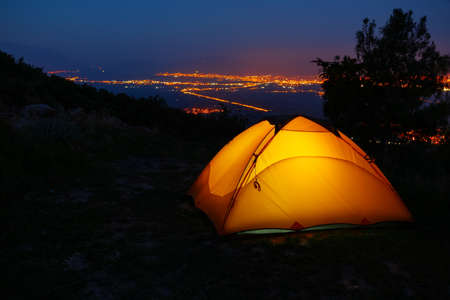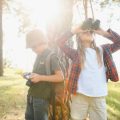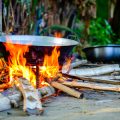1. Choosing the Right Campsite
When it comes to solo car camping, picking the right campsite is one of the most important decisions youll make. The perfect spot should feel safe, be easy to access, and ideally offer some great views or peaceful surroundings. Here are some tips to help you choose wisely when youre hitting the road alone.
Safety First
Your personal safety is the top priority when camping solo. Look for campgrounds that are well-maintained and have good reviews from other solo travelers. Public campgrounds run by state or national parks are usually a safe bet because they tend to be patrolled regularly and have clear rules in place.
Things to Consider:
- Lighting: Some campgrounds have minimal lighting, so bring your own light sources if needed.
- Camp Hosts: Sites with on-site hosts can be a plus—theyre often experienced campers who can assist if something goes wrong.
- Other Campers: If possible, park near families or fellow solo travelers rather than large groups.
Accessibility
Solo camping means you’ll be doing all the setup and packing yourself, so convenience matters. Choose a site that’s easy to drive into and doesn’t require a long walk from the parking area to your tent or vehicle.
Key Accessibility Features:
| Feature | Why It Matters |
|---|---|
| Paved Roads | Makes it easier to reach your site without getting stuck or damaging your car |
| Flat Surface | Simplifies leveling your vehicle and setting up camp |
| Close Parking | You won’t have to carry gear far—especially helpful when traveling alone |
Amenities Nearby
A solo trip doesn’t mean roughing it completely. Having access to basic amenities can make your experience smoother and more enjoyable.
Look For Campsites Near:
- Restrooms: Especially important for comfort and hygiene on longer stays.
- Water Sources: Whether it’s a faucet or a nearby store, don’t rely solely on what you packed.
- Trash Disposal: Makes cleanup easier and reduces wildlife risks at your site.
Cell Service & Emergency Access
You might want to unplug—but staying connected is still important for safety reasons. Make sure your chosen campsite has decent cell reception or isn’t too far from areas where you can get a signal.
If Youre Unsure About Coverage:
- Check coverage maps: Most major carriers like Verizon, AT&T, and T-Mobile provide online tools to check signal strength in specific areas.
- Talk to rangers or staff: They often know where coverage is strong or spotty within the park or campground.
Permitted Areas Only
Campsite legality is crucial—camping in unauthorized places can lead to fines or dangerous encounters. Stick to designated campgrounds or dispersed camping areas where its legally allowed.
How to Check Legality:
- Bureau of Land Management (BLM) Maps: Great for finding free dispersed sites in the western U.S.
- National Forest Service Websites: Often list permitted camping zones along with rules for fires and stay limits.
- Campsite Apps: Try apps like Campendium or The Dyrt for user reviews and legal status updates.
The right campsite can set the tone for your entire trip—choose one that keeps you safe, makes things easier, and lets you enjoy the journey ahead.
2. Packing Smart for Solo Trips
When youre heading out on a solo car camping trip, packing smart is key to making your adventure smooth, safe, and stress-free. Since you’ll be relying entirely on yourself, it’s important to bring the right gear and keep it organized for quick access and easy setup or breakdown.
Essential Gear Checklist
Here’s a rundown of must-have items that focus on self-reliance and safety:
| Category | Gear | Why You Need It |
|---|---|---|
| Shelter & Sleeping | Sleeping bag, camping mattress, pillow, window shades or privacy curtains | Comfortable rest and privacy are crucial, especially when sleeping in your vehicle |
| Lighting | Headlamp, lantern, string lights, extra batteries | You’ll need reliable lighting for camp setup and nighttime tasks |
| Cooking & Food Storage | Portable stove, fuel, cookware, utensils, cooler or fridge, dry food storage bins | Allows you to cook safely and store food properly without attracting wildlife |
| Safety & Navigation | First aid kit, pepper spray (where legal), GPS device or maps, multi-tool | Helps you stay safe in emergencies and navigate unfamiliar areas confidently |
| Hygiene & Health | Wet wipes, biodegradable soap, toothbrush kit, menstrual products (if needed) | Keeps you feeling clean and comfortable during your solo trip |
| Power & Communication | Portable charger/power bank, solar panel (optional), phone with service or emergency beacon | You’ll want a way to stay connected or call for help if necessary |
Packing Tips for Efficiency and Safety
Use Clear Storage Bins
Clear plastic bins let you see what’s inside without opening everything. Group similar items together—like all cooking gear in one bin—to make grabbing what you need quick and easy.
Create a Setup-Friendly Layout
Packing your car strategically helps when setting up camp. Keep frequently used items near the back door or trunk area so you don’t have to dig through everything. Think about your nightly routine and pack accordingly.
Always Have an Emergency Grab Bag
This small bag should include essentials like your first aid kit, flashlight/headlamp, multitool, water bottle, snacks, and ID. Keep it within reach at all times—you never know when you might need to grab it fast.
Label Everything
If youre using multiple containers or bags, label them clearly. This reduces time spent searching for things like your cooking gear or hygiene supplies when you’re tired after a long day of driving.
A Quick Setup/Breakdown Checklist
| Task | Description |
|---|---|
| Park Level | Select flat ground to avoid sliding in your sleep or uneven cooking surfaces. |
| Ventilation Setup | Certain windows should be cracked open slightly with bug nets for airflow. |
| Bedding Ready-to-Go | Keep your sleeping area made up so its ready anytime you want to rest. |
| Lamps Positioned Early | Set up lights before sunset so youre not scrambling in the dark. |
| Bears/Wildlife Protocols Followed | Store food in sealed containers away from where you sleep—inside a bear-proof box if available. |
Packing smart isn’t just about saving space—it’s about being prepared for anything. When you’re traveling solo, efficient packing can mean the difference between comfort and chaos. Take the time to plan ahead so you can enjoy the freedom of the road with peace of mind.
![]()
3. Staying Safe While Camping Alone
Solo car camping can be an incredibly rewarding experience, but safety should always come first. When youre out there on your own, its important to take extra steps to ensure your well-being. Here are some best practices to help you stay safe while enjoying your solo adventure.
Let Someone Know Your Plans
Before heading out, always share your trip details with a trusted friend or family member. Include information like where youre going, when you expect to arrive and leave, and how often youll check in. This way, if something goes wrong, someone knows where to start looking for you.
Suggested Info to Share:
| Information | Details |
|---|---|
| Destination | Park or campground name and specific site number if available |
| Dates | Departure and return dates/times |
| Vehicle Info | Make, model, color, and license plate number |
| Emergency Contacts | Your emergency contacts and local authorities near the camp area |
Secure Your Campsite
A secure campsite helps you sleep better and avoid unwanted surprises. Choose a spot that feels safe—well-lit areas near other campers are usually a good choice. Lock your vehicle when not in use and keep valuables out of sight. If youre staying in a dispersed area, make sure youre not too isolated.
Campsite Safety Tips:
- Keep a flashlight or headlamp within reach at all times.
- Use motion sensor lights or battery-operated lanterns to deter wildlife or strangers.
- Dont advertise that youre alone; avoid oversharing on social media in real-time.
- Trust your gut—if a location feels off, move somewhere else.
Be Prepared for Emergencies
No one wants to think about emergencies while camping, but being prepared can make all the difference. Carry a well-stocked first aid kit, extra food and water, maps (both physical and digital), and a portable power bank for your phone. Know the nearest hospital or ranger station just in case.
Emergency Essentials Checklist:
| Item | Purpose |
|---|---|
| First Aid Kit | Treat minor injuries quickly and effectively |
| Extra Food & Water | Sustain yourself in case of delays or issues |
| Offline Maps/GPS Device | Navigating areas without cell service |
| Portable Charger/Power Bank | Keep devices charged during emergencies |
Trust Your Instincts
This might be the most important tip of all: trust your gut. If something—or someone—doesnt feel right, dont hesitate to leave. Your intuition is a powerful tool. Whether it’s relocating your campsite or cutting your trip short, it’s always better to be safe than sorry.
Quick Tip:
If you ever feel uneasy at night, getting into your car and locking the doors is a fast way to feel more secure while you decide what to do next.
Your safety matters more than sticking to the original plan. Stay alert, stay smart, and enjoy every moment of your solo car camping journey.
4. Maximizing Comfort and Enjoyment
Solo car camping isn’t just about getting away—it’s also a chance to recharge, reflect, and enjoy your own company. Here are some easy ways to make your solo adventure more comfortable and fun.
Create a Cozy Sleeping Setup
Your car is your home base, so make it as comfy as possible. Whether youre sleeping in the backseat or the cargo area, invest in a good-quality sleeping pad or inflatable mattress that fits your vehicle’s space. Add soft blankets and a supportive pillow to help you sleep better after a long day of exploring.
Quick Tips for a Comfy Sleep
| Item | Why It Helps |
|---|---|
| Sleeping Pad or Air Mattress | Provides insulation and cushioning from the car floor |
| Warm Blanket or Sleeping Bag | Keeps you warm during cooler nights |
| Pillow or Neck Pillow | Supports your neck and improves sleep quality |
| Window Covers or Curtains | Adds privacy and blocks out light |
Plan Easy and Tasty Meals
Good food can lift your mood and fuel your adventures. When youre camping solo, its best to keep meals simple but satisfying. Prepping meals ahead of time saves hassle at the campsite. Bring along a cooler with pre-cooked options, or pack ingredients for easy-to-make dishes like sandwiches, wraps, or instant noodles.
Sample Solo Meal Plan
| Meal | Ideas |
|---|---|
| Breakfast | Granola with milk or yogurt, fruit, instant coffee |
| Lunch | Tuna salad wrap, trail mix, apple slices |
| Dinner | Pre-cooked pasta with sauce, grilled cheese sandwich, soup in a thermos |
Add Relaxing Entertainment Options
You don’t have to be busy all the time—solo trips are perfect for slowing down. Bring along a few things that help you unwind. A good book, a journal for jotting down thoughts, or some downloaded podcasts can keep you entertained during quiet moments. And if you’re parked somewhere remote, stargazing is always a magical way to end the day.
Fun Things To Bring for Solo Entertainment
- A novel or e-reader loaded with books
- A notebook or travel journal and pens
- A deck of cards or small games for solo play
- Offline playlists or podcasts on your phone
- A foldable chair or blanket for stargazing outside the car
Create Your Own Comfort Rituals
The beauty of solo car camping is that everything runs on your schedule. You get to decide when to wake up, when to eat, and how to spend your time. Consider starting small rituals like enjoying coffee at sunrise or writing in your journal before bed. These little routines can bring structure and joy to your trip.
Pro Tip:
If youre staying at multiple spots during your trip, keep your gear organized in labeled bins so you can find things quickly without unpacking everything each time.
Making the most of your solo car camping trip means taking care of both comfort and enjoyment. With just a bit of planning, you’ll create an experience that’s not only safe—but truly memorable.
5. Connecting with Nature and Yourself
One of the most powerful aspects of solo car camping is the chance to truly connect—with nature and with yourself. When youre out on your own, surrounded by mountains, forests, or desert skies, the noise of everyday life fades away. This quiet space creates room for reflection, mindfulness, and personal growth.
Mindfulness in the Outdoors
Being alone in nature encourages you to slow down and become more aware of your surroundings. You start noticing the sound of wind through the trees, the way sunlight filters through branches, or how stars fill the sky at night. These moments help ground you in the present.
Easy Ways to Practice Mindfulness While Camping
| Activity | How It Helps |
|---|---|
| Morning coffee outside | Takes time to enjoy silence and scenery before starting your day |
| Nature walks without music | Helps you tune into natural sounds and movements around you |
| Journaling at camp | Encourages self-reflection and emotional clarity |
Building Independence and Confidence
Traveling solo—especially when youre responsible for setting up camp, cooking meals, and navigating on your own—builds real confidence. Every small win, like lighting a fire or choosing a good campsite, boosts your sense of independence.
Solo Wins That Build Confidence
- Successfully planning your route and stops
- Troubleshooting issues like a dead battery or bad weather
- Sleeping peacefully in your car knowing youve set up safely
A Deeper Bond with Nature
Without distractions from other people or technology, its easier to feel connected to the world around you. Many solo campers say they feel more grounded and refreshed after spending time alone in nature—it’s like hitting a mental reset button.
Tip:
If you want to deepen this connection, try staying off your phone (except for safety) and doing simple things like stargazing or identifying local plants and animals.
Solo car camping isn’t just an adventure—it’s a chance to reconnect with what really matters: peace, presence, and purpose.


